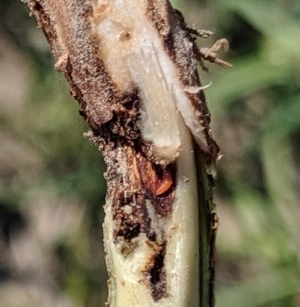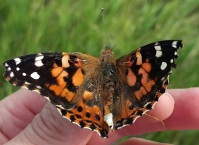Upcoming Events:
July 15: CSI for Youth, 5-6 p.m., jrees2@unl.eduJuly 17-19:Solar Design and Installation Hands-on Workshop, Lincoln, NE
July 18-19: Good Farmer to Great Manager, Extension Office, Lincoln
July 19:Communicating with Farmers Under Stress, 9-11 a.m., ENREC (former ARDC) near Mead, RSVP: 402-624-8003
July 24:Science and Ag Family Field Day, 9 a.m.-3 p.m., Haskell Ag Lab, Concord
July 30-31:Good Farmer to Great Manager, Extension Office, Grand Island
Interesting, memorable don’t seem to capture this year. While portions of Nebraska are flooding again, many growers in this part of the state and east would like some rain. Dr. Suat Irmak shares on understanding matric potential and water content thresholds on sensors for irrigation scheduling in this CropWatch article: https://go.unl.edu/miym.
Soybean: The large number of painted lady butterflies we experienced in late May/June was due to a wet season in Mexico that allowed for greater vegetative growth and survival for northern migration, according to Bob Wright, Extension Entomologist. The cooler conditions may have caused more to stay here instead of move north. Saw newly hatched to early instars of thistle caterpillar (the larvae of painted lady butterflies) this week. Yet, a tremendous number of butterflies are still laying eggs. A painted lady female can lay up to 500 pale green eggs on plants individually instead of in egg masses. The larvae hatch in around a week and can feed from 2-6 weeks depending on weather conditions. Other defoliators including various worms, grasshoppers, Japanese beetles are also present. Thresholds for damage for all soybean defoliators is 20% defoliation of plants during the reproductive stages. If you’re unsure what 20% defoliation in soybean looks like, check out the graphic in CropWatch at: https://go.unl.edu/v0ts. If your primary defoliator is thistle caterpillars, it’s important to use insecticides that can be effective on them once their ‘tents’ are built. The 2019 Guide for Weed, Disease, Insect Management gives information regarding products that may work better on pages 308-314.
Gall Midge in Seward County: My colleague Aaron Nygren found soybean gall midge in

Gall midge (orange colored worm)
Seward County north of Bee this past week. I was a few miles away so met him at the field. Being a new insect pest, little is known about it. Infected plants show signs of wilting from larvae feeding within the base of the stem. These plants will eventually die. To scout for soybean gall midge, focus on plants that are close to the field edge and adjacent to fields that were planted to soybean in 2018. If you’re seeing wilted/dying plants, particularly in early planted beans this year, please contact your local Extension educator. More information at: https://cropwatch.unl.edu/gallmidge.
Bob Wright is asking for help to understand distribution of the green June beetle, Japanese beetle, and brown marmorated stink bug. If you see these insects, please take a picture and upload it to: inaturalist.org, including information on where the photo was taken. You need to make an account with inaturalist.org before you can upload photos. And, if you’re unsure what these insects look like, you can view them at: https://go.unl.edu/uzd0.
Corn: Looked at numerous corn leaves but so far, only common rust in Nebraska. Southern rust was confirmed in southern Kansas and Missouri this past week. You can view U.S. counties where southern rust has been confirmed at: https://corn.ipmpipe.org/southerncornrust/.
As we approach tasseling: 1-Areas of fields that had water ponded this

Tassels appear leafy in crazy top of corn. Took this pic from flooded waterway area in 2017.
growing season may show crazy top of corn. Crazy top symptoms include when the tassel appears strange and leafy. Plants can be barren, have barren kernels on ears, or have multiple ears at shank. 2-Automatic fungicide applications at tassel: I prefer waiting till disease warrants application & Nebraska research shows fungicide applications later in the season are effective. Be careful if you automatically spray at tassel! Canopy closure covered problems in fields, including uneven growth stages. Plants in the field may have tassels with others several growth stages behind. Arrested ear development primarily occurs on plants from 12-14 leaves when surfactants (particularly non-ionic) are applied with fungicides. So, it’s important to know your growth stages and consider what you’re applying. 3-Japanese beetles in corn threshold: Three or more Japanese beetles per ear with silks clipped to less than ½ inch and pollination is less than 50% complete. 4-It’s OK to fertigate pollinating corn. Avoid running pivot from 6 a.m.-Noon during pollination. Can apply 30 lbs N in 0.25″ water or up to 60 lbs N in 0.50″.
Linden trees and Japanese beetles: Last week I didn’t stress the importance of insecticides and impact to bees when spraying linden trees. ‘Sevin’ is effective but highly toxic to bees. It’s better to use heavy streams of water in late afternoon to knock Japanese beetles down (then drown in soapy water), pyrethroids, or permethrin like ‘Eight’ as those products are not taken back to the hives.





































